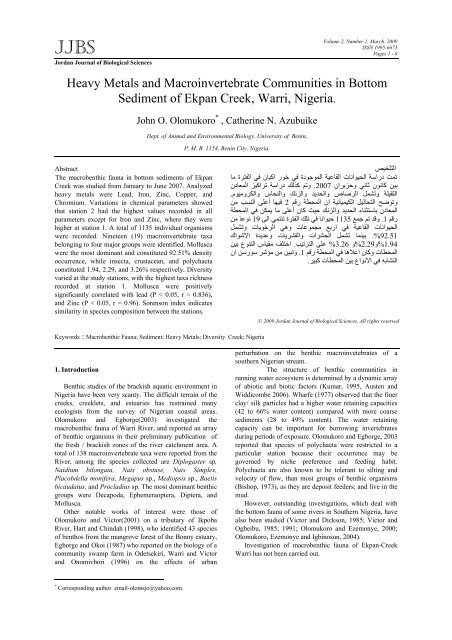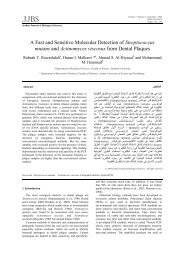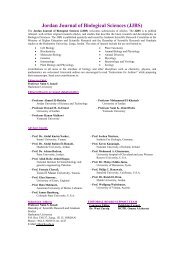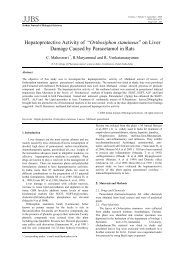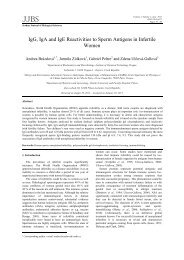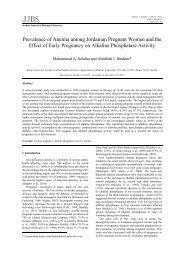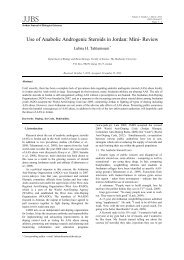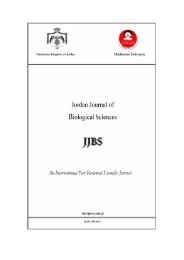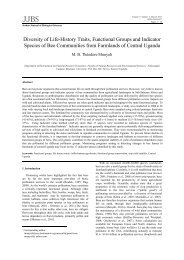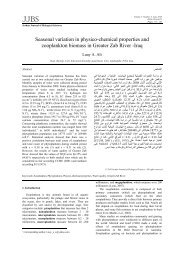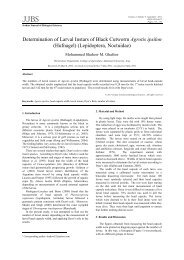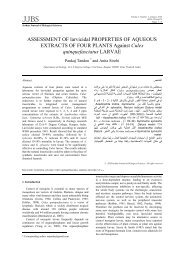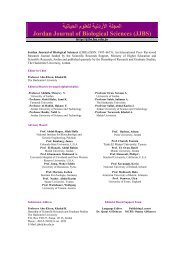Heavy Metals and Macroinvertebrate Communities in Bottom ...
Heavy Metals and Macroinvertebrate Communities in Bottom ...
Heavy Metals and Macroinvertebrate Communities in Bottom ...
Create successful ePaper yourself
Turn your PDF publications into a flip-book with our unique Google optimized e-Paper software.
JJBS<br />
Jordan Journal of Biological Sciences<br />
Volume 2, Number 1, March. 2009<br />
ISSN 1995-6673<br />
Pages 1 - 8<br />
<strong>Heavy</strong> <strong>Metals</strong> <strong>and</strong> <strong>Macro<strong>in</strong>vertebrate</strong> <strong>Communities</strong> <strong>in</strong> <strong>Bottom</strong><br />
Sediment of Ekpan Creek, Warri, Nigeria.<br />
John O. Olomukoro * , Cather<strong>in</strong>e N. Azubuike<br />
Dept. of Animal <strong>and</strong> Environmental Biology, University of Ben<strong>in</strong>,<br />
P. M. B. 1154, Ben<strong>in</strong> City, Nigeria.<br />
Abstract<br />
ﺺﻴﺨﻠﺘﻟا<br />
The macrobenthic fauna <strong>in</strong> bottom sediments of Ekpan ﺎﻣ ةﺮﺘﻔﻟا ﻲﻓ نﺎﺒآا رﻮﺧ ﻲﻓ ةدﻮﺟﻮﻤﻟا ﺔﻴﻋﺎﻘﻟا تﺎﻧاﻮﻴﺤﻟا ﺔﺳارد ﺖﻤﺗ<br />
Creek was studied from January to June 2007. Analyzed ندﺎﻌﻤﻟا ﺰﻴآاﺮﺗ ﺔﺳارد ﻚﻟﺬآ ﻢﺗو . 2007 ناﺮﻳﺰﺣو ﻲﻧﺎﺛ نﻮﻧﺎآ ﻦﻴﺑ<br />
heavy metals were Lead, Iron, Z<strong>in</strong>c, Copper, <strong>and</strong> . مﻮﻴﻣوﺮﻜﻟاو سﺎﺤﻨﻟاو ﻚﻧﺰﻟاو ﺪﻳﺪﺤﻟاو صﺎﺻﺮﻟا ﻞﻤﺸﺗو ﺔﻠﻴﻘﺜﻟا<br />
Chromium. Variations <strong>in</strong> chemical parameters showed ﻦﻣ ﺐﺴﻨﻟا ﻰﻠﻋأ ﺎﻬﻴﻓ 2 ﻢﻗر ﺔﻄﺤﻤﻟا نا ﺔﻴﺋﺎﻴﻤﻴﻜﻟا ﻞﻴﻟﺎﺤﺘﻟا ﺢﺿﻮﺗو<br />
that station 2 had the highest values recorded <strong>in</strong> all ﺔﻄﺤﻤﻟا ﻲﻓ ﻦﻜﻤﻳ ﺎﻣ ﻰﻠﻋأ نﺎآ ﺚﻴﺣ ﻚﻧﺰﻟاو ﺪﻳﺪﺤﻟا ءﺎﻨﺜﺘﺳﺎﺑ ندﺎﻌﻤﻟا<br />
parameters except for Iron <strong>and</strong> Z<strong>in</strong>c, where they were ﻦﻣ ﺎﻋﻮﻧ 19 ﻰﻟا ﻲﻤﺘﻨﺗ<br />
ةﺮﺘﻔﻟا ﻚﻠﺗ ﻲﻓ ﺎﻧاﻮﻴﺣ 1135 ﻊﻤﺟ ﻢﺗ ﺪﻗو . 1 ﻢﻗر<br />
higher at station 1. A total of 1135 <strong>in</strong>dividual organisms ﻞﻤﺸﺗو تﺎﻳﻮﺧﺮﻟا ﻲهو تﺎﻋﻮﻤﺠﻣ ﻊﺑرا ﻲﻓ ﺔﻴﻋﺎﻘﻟا تﺎﻧاﻮﻴﺤﻟا<br />
were recorded. N<strong>in</strong>eteen (19) macro<strong>in</strong>vertebrate taxa كاﻮﺷﻻا ةﺪﻳﺪﻋو تﺎﻳﺮﺸﻘﻟاو تاﺮﺸﺤﻟا ﻞﻤﺸﺗ ﺎﻤﻨﻴﺑ .% 92.51<br />
belong<strong>in</strong>g to four major groups were identified. Mollusca ﻦﻴﺑ عﻮﻨﺘﻟا سﺎﻴﻘﻣ ﻒﻠﺘﺧا . ﺐﻴﺗﺮﺘﻟا ﻰﻠﻋ % 3.26 و%<br />
2.29و%<br />
1.94<br />
were the most dom<strong>in</strong>ant <strong>and</strong> constituted 92.51% density نا ﻦﺳرﻮﺳ ﺮﺷﺆﻣ ﻦﻣ ﻦﻴﺒﺗو . 1 ﻢﻗر ﺔﻄﺤﻤﻟا ﻲﻓ ﺎهﻼﻋا نﺎآو تﺎﻄﺤﻤﻟا<br />
occurrence, while <strong>in</strong>secta, crustacean, <strong>and</strong> polychaeta<br />
constituted 1.94, 2.29, <strong>and</strong> 3.26% respectively. Diversity<br />
varied at the study stations, with the highest taxa richness<br />
recorded at station 1. Mollusca were positively<br />
significantly correlated with lead (P < 0.05, r = 0.836),<br />
<strong>and</strong> Z<strong>in</strong>c (P < 0.05, r = 0.96). Sorenson <strong>in</strong>dex <strong>in</strong>dicates<br />
similarity <strong>in</strong> species composition between the stations.<br />
. ﺮﻴﺒآ تﺎﻄﺤﻤﻟا ﻦﻴﺑ عاﻮﻧﻻا ﻲﻓ ﻪﺑﺎﺸﺘﻟا<br />
Keywords : Macrobenthic Fauna; Sediment; <strong>Heavy</strong> <strong>Metals</strong>; Diversity Creek; Nigeria<br />
1. Introduction *<br />
Benthic studies of the brackish aquatic environment <strong>in</strong><br />
Nigeria<br />
have been very scanty. The difficult terra<strong>in</strong> of the<br />
creeks, creeklets, <strong>and</strong> estuaries has restra<strong>in</strong>ed many<br />
ecologists from the survey of Nigerian coastal areas.<br />
Olomukoro <strong>and</strong> Egborge(2003) <strong>in</strong>vestigated the<br />
macrobenthic fauna of Warri River, <strong>and</strong> reported an array<br />
of benthic organisms <strong>in</strong> their prelim<strong>in</strong>ary publication of<br />
the fresh / brackish zones of the river catchment area. A<br />
total of 138 macro<strong>in</strong>vertebrate taxa were reported from the<br />
River, among the species collected are Diplogaster sp,<br />
Naidium bilongata, Nais obstuse, Nais Simplex,<br />
Placobdella monifera, Megapus sp., Mediopsis sp., Baetis<br />
bicaudatus, <strong>and</strong> Procladius sp. The most dom<strong>in</strong>ant benthic<br />
groups were Decapoda, Ephemeraoptera, Diptera, <strong>and</strong><br />
Mollusca.<br />
Other notable works of <strong>in</strong>terest were those of<br />
Olomukoro<br />
<strong>and</strong> Victor(2001) on a tributary of Ikpoba<br />
River, Hart <strong>and</strong> Ch<strong>in</strong>dah (1998), who identified 43 species<br />
of benthos from the mangrove forest of the Bonny estuary,<br />
Egborge <strong>and</strong> Okoi (1987) who reported on the biology of a<br />
community swamp farm <strong>in</strong> Odetsekiri, Warri <strong>and</strong> Victor<br />
<strong>and</strong> Onomivbori (1996) on the effects of urban<br />
* Correspond<strong>in</strong>g author. email-olomsjo@yahoo.com.<br />
© 2009 Jordan Journal of Biological Sciences. All rights reserved<br />
perturbation on the benthic macro<strong>in</strong>vetebrates of a<br />
southern Nigerian stream.<br />
The structure of benthic communities <strong>in</strong><br />
runn<strong>in</strong>g water ecosystem is determ<strong>in</strong>ed by a dynamic array<br />
of abiotic <strong>and</strong> biotic factors (Kumar, 1995, Austen <strong>and</strong><br />
Widdicombe 2006). Wharfe (1977) observed that the f<strong>in</strong>er<br />
clay/ silk particles had a higher water reta<strong>in</strong><strong>in</strong>g capacities<br />
(42 to 66% water content) compared with more coarse<br />
sediments (28 to 49% content). The water reta<strong>in</strong><strong>in</strong>g<br />
capacity can be important for burrow<strong>in</strong>g <strong>in</strong>vertebrates<br />
dur<strong>in</strong>g periods of exposure. Olomukoro <strong>and</strong> Egborge, 2003<br />
reported that species of polychaeta were restricted to a<br />
particular station because their occurrence may be<br />
governed by niche preference <strong>and</strong> feed<strong>in</strong>g habit.<br />
Polychaeta are also known to be tolerant to silt<strong>in</strong>g <strong>and</strong><br />
velocity of flow, than most groups of benthic organisms<br />
(Bishop, 1973), as they are deposit feeders; <strong>and</strong> live <strong>in</strong> the<br />
mud.<br />
However, outst<strong>and</strong><strong>in</strong>g <strong>in</strong>vestigations, which deal with<br />
the bottom<br />
fauna of some rivers <strong>in</strong> Southern Nigeria, have<br />
also<br />
been studied (Victor <strong>and</strong> Dickson, 1985; Victor <strong>and</strong><br />
Ogbeibu, 1985; 1991; Olomukoro <strong>and</strong> Ezemonye, 2000;<br />
Olomukoro, Ezemonye <strong>and</strong> Igb<strong>in</strong>osun, 2004).<br />
Investigation of macrobenthic fauna of Ekpan-Creek<br />
Warri has not been carried out.
2<br />
Figure1. Map of Warri Show<strong>in</strong>g the Sampled Stations.<br />
© 2009 Jordan Journal of Biological Sciences. All rights reserved - Volume 2, Number 1<br />
The bottom sediment fauna study is to provide basel<strong>in</strong>e<br />
<strong>in</strong>formation on which subsequent works would be based.<br />
The objectives are to exam<strong>in</strong>e the composition, abundance,<br />
diversity of benthos, <strong>and</strong> the heavy metals of the bottom<br />
sediment of Ekpan Creek, Warri.<br />
2. Study Area<br />
Ekpan Creek is located with<strong>in</strong> Effurun-Warri of Delta<br />
State <strong>in</strong> Southern Nigeria (Latitude 5 0 3 011 -5 0 3 011 <strong>and</strong><br />
longitude 5 0 40 11 - 5 0 44 11 E). The Creek, which is about<br />
12km long, takes its source from Effurun. It flows through<br />
the city (westernly) <strong>in</strong>to Tori Creek at NNPC Jetty, <strong>and</strong><br />
empties <strong>in</strong>to Warri River at Bennet Isl<strong>and</strong>.<br />
a. Sampl<strong>in</strong>g Location<br />
Three sampl<strong>in</strong>g stations were chosen (Figure1) for their<br />
proximity to facilities, structures or human activities that<br />
could potentially affect water quality <strong>and</strong> biodiversity.<br />
Station I is located close to the creek source. Water depth<br />
is 2.20 ± 3.74m, <strong>and</strong> the velocity of flow (1.07 ± 0.46m/S)<br />
is m<strong>in</strong>imal <strong>and</strong> the bank is flanked with red mangrove,<br />
(Rhizophora racemosa), planta<strong>in</strong> tree (Musa sp.) <strong>and</strong> some<br />
shrubs. This water is murky <strong>and</strong> turbid, <strong>and</strong> the substratum<br />
is made of clay <strong>and</strong> mud. Human activities <strong>in</strong>clude fish<strong>in</strong>g,<br />
bath<strong>in</strong>g, <strong>and</strong> laundry.<br />
Station II is about 4km from station one. It is located at<br />
the bridge, close to NNPC hous<strong>in</strong>g complex. Water depth<br />
is 4.10 ± 7.72, <strong>and</strong> the flow rate (1.49 ± 0.11m/S) is faster<br />
than station I. The substratum is a comb<strong>in</strong>ation of s<strong>and</strong>,<br />
silt, <strong>and</strong> clay. Marg<strong>in</strong>al vegetation consists of Rhizophora<br />
recemosa (red mangrove), few grasses. Human activities<br />
<strong>in</strong>clude fish<strong>in</strong>g, <strong>and</strong> the use of the water for construction.<br />
Station III is located at the Chevron-Texaco company<br />
bridge site, 5km from station II. The substratum is a<br />
mixture of s<strong>and</strong> <strong>and</strong> silt. Water depth is 6.50 ± 8.46m/S,<br />
<strong>and</strong> the velocity of flow is very fast, about 1.48 ± 0.14m/S.<br />
Oil film dots the water surface.<br />
3. Material <strong>and</strong> Methods<br />
a. Sampl<strong>in</strong>g Techniques<br />
Benthic samples were collected fortnightly from the<br />
study stations from January to June 2007, us<strong>in</strong>g an Ekpan<br />
grab operated by h<strong>and</strong> <strong>in</strong> shallow water. It is recommended<br />
for s<strong>and</strong> <strong>and</strong> silt (Hynes, 1971). A 6-<strong>in</strong>ch Ekman grab was<br />
forced <strong>in</strong>to the substratum to depth of 15-20cm. Contents<br />
trapped by the grab were processed us<strong>in</strong>g the technique,<br />
earlier described by Hynes 1971. Sieved <strong>and</strong> sorted<br />
organisms were preserved <strong>in</strong> 4% formal<strong>in</strong>. <strong>Bottom</strong><br />
sediment samples were collected with grab at monthly<br />
<strong>in</strong>tervals <strong>in</strong> polythene bags for heavy metals analysis.<br />
b. Digestion <strong>and</strong> Sediment Analysis<br />
Sediment samples were digested, us<strong>in</strong>g the nitric acid,<br />
perchloric acid method (APHA 1997). An atomic<br />
absorption spectrophotometer (model pycunicam sp. 2900)<br />
was also used for the analysis of lead, Iron, Z<strong>in</strong>c, copper<br />
<strong>and</strong> Chromium. Identification of organisms was possible<br />
by us<strong>in</strong>g appropriate keys <strong>and</strong> works of Mellanby, 1963;<br />
Needham & Needham, 1962; Pennak 1978, <strong>and</strong><br />
Olomukoro, 1996.
© 2009 Jordan Journal of Biological Sciences. All rights reserved - Volume 2, Number 1 3<br />
Figure2. Monthly variation <strong>in</strong> iron concentrations <strong>in</strong><br />
Ekpan Creek.<br />
Figure 3. Monthly variation <strong>in</strong> lead concentrations <strong>in</strong><br />
Ekpan Creek.<br />
c. Statistical Analysis<br />
Biological <strong>in</strong>dices, Margalef’s <strong>in</strong>dex (d); Shannon–<br />
We<strong>in</strong>er <strong>in</strong>dex (H), <strong>and</strong> Evenness E were used <strong>in</strong> the<br />
calculation of taxa richness, general diversity. <strong>and</strong><br />
evenness (Green, 1971 <strong>and</strong> Rob<strong>in</strong>son <strong>and</strong> Rob<strong>in</strong>son,<br />
1971). The faunal of the stations were compared. us<strong>in</strong>g<br />
Sorenson’s quotient (Sorenson 1948) of similarities. Both,<br />
the correlation coefficient of chemical variables <strong>and</strong><br />
benthic organisms were computed. ANOVA DUNCA<br />
comb<strong>in</strong>ed test was used <strong>in</strong> calculat<strong>in</strong>g the mean value of<br />
the heavy metals of the stations. One way Analysis of<br />
variance <strong>and</strong> Pearson’s correlation coefficient were used <strong>in</strong><br />
the statistical analysis of chemical variables at 5% level of<br />
significance.<br />
4. Results<br />
a. SEDIMENT<br />
The summary of the heavy metals concentration values<br />
of the sediment of Ekpan creek study stations is presented<br />
<strong>in</strong> Table 1.<br />
Figure 4.Monthly variation <strong>in</strong> z<strong>in</strong>c concentrations <strong>in</strong> Ekpan Creek.<br />
Figure 5.Monthly variation <strong>in</strong> copper concentrations <strong>in</strong> Ekpan<br />
Creek.<br />
Figure 6. Monthly variation <strong>in</strong> chromium concentrations <strong>in</strong> Ekpan<br />
Creek.<br />
Iron <strong>and</strong> Z<strong>in</strong>c concentration values were higher <strong>in</strong><br />
January at stations II <strong>and</strong> I than <strong>in</strong> station III (Figs 2 <strong>and</strong><br />
3). The values of these metals ranged from 6.67 to 93.33<br />
mg/kg <strong>and</strong> 1.21 to 19.60mg/kg <strong>in</strong> the stations.<br />
However, the <strong>in</strong>creases <strong>in</strong> Lead (ranged from 0.59 to<br />
55.00mg/kg), Copper (0.47 to 23.30mg/kg) <strong>and</strong> Chromium<br />
(02.02 to 54.74mg/kg) concentration values were high <strong>in</strong><br />
the month of March <strong>in</strong> all the stations, but very low <strong>in</strong><br />
May, particularly at station III (Figs. 4, 5 <strong>and</strong> 6)
4<br />
b. Macrobenthic Invertebrate Fauna<br />
© 2009 Jordan Journal of Biological Sciences. All rights reserved - Volume 2, Number 1<br />
A total of 19 macro <strong>in</strong>vertebrate taxa compris<strong>in</strong>g 1,135<br />
<strong>in</strong>dividuals <strong>in</strong>clude 3 species of polychaeta, 1 species of<br />
Decapoda, 3 species of Diptera, 1 species of Lepidoptera<br />
<strong>and</strong> 11 species of Mollusca.<br />
Table 1. The summary of chemical parameters <strong>in</strong> the three study stations of Ekpan Creek.<br />
STATION 1 STATION 2 STATION 3<br />
Parameter Units N Mean ± S. E M<strong>in</strong> - Max Mean ± S. E M<strong>in</strong> – Max Mean ± S. E M<strong>in</strong> – Max<br />
Lead mg/kg 6 8.52 ± 6.79 – 42.50 13.09 ± 8.44 1.30 – 55.00 4.85 ± 4.03 0.59 – 25.00<br />
Iron mg/kg 6 41.11 ± 8.93 16.67 – 70.00 58.39 ± 8.94 26.67 – 93.33 28.33 ± 9.10 6.67 – 66.67<br />
Z<strong>in</strong>c mg/kg 6 9.16 ± 2.29 4.87 – 19.60 10.58 ± 1.43 6.96 – 15.30 4.78 ± 1.85 1.21 – 12.70<br />
Copper mg/kg 6 6.26 ± 2.93 0.69 – 20.30 8.67 ± 3..21 1.59 – 23.30 4.22 ± 2.05 0.47 – 14.00<br />
Chromium mg/kg 6 16.51 ± 6.49 2.98 – 43.16 21.79 ± 9.10 4.00 – 54.74 14.89 ± 6.86 2.02 – 37.89<br />
Figure 7. Monthly variation <strong>in</strong> the distribution of macrobenthic <strong>in</strong>vertebrate groups.<br />
The overall taxa composition, distribution, <strong>and</strong><br />
abundance of macrobenthic <strong>in</strong>vertebrates collected dur<strong>in</strong>g<br />
the study period are presented <strong>in</strong> Table 2. Individuals<br />
organisms were dom<strong>in</strong>ated by Mollusca, which constituted<br />
92.51% density occurrence, while polychaeta, crustacea<br />
<strong>and</strong> <strong>in</strong>secta made up of 3.26, 2.29 <strong>and</strong> 1.94% respectively<br />
Table 3. as also found <strong>in</strong> station 2.<br />
Ampullariidae (Pilidae) had Pila ovata at station 3 <strong>in</strong><br />
the month of February as a s<strong>in</strong>gle record.<br />
Assim<strong>in</strong>eidae was represented by the Assim<strong>in</strong>ea hessei<br />
Polychaeta was represented by Namanereis<br />
hawaiiensis, Lycastopsi sp <strong>and</strong> Nereis sp. This was<br />
represented <strong>in</strong> the months of March, June, January, April,<br />
<strong>and</strong> May <strong>in</strong> all the stations (Figure 7)<br />
Potamalpheops monodi (Apheidae, Crustacea)<br />
occurred <strong>in</strong> all stations with highest occurrence <strong>in</strong> station I,<br />
<strong>and</strong> it was recorded <strong>in</strong> February, March, <strong>and</strong> June (Figure<br />
7).<br />
Chironomidae (Diptera) was represented by<br />
Chironomus sp. Tanytarsus sp. <strong>and</strong> Tanypus sp., <strong>and</strong> were<br />
recorded <strong>in</strong> all stations <strong>in</strong> February, March, April, <strong>and</strong><br />
June.<br />
A s<strong>in</strong>gle Lepidopteran larva was found <strong>in</strong> the month of<br />
February <strong>in</strong> station 2.<br />
Gastropoda recorded <strong>in</strong> the Creek consists of five<br />
families viz Neritidae, Hydrobiidae., Potamididae, Pilidae,<br />
<strong>and</strong> Assim<strong>in</strong>eidae. Neritidae was represented by Nerit<strong>in</strong>a<br />
glabrata <strong>and</strong> Nerita senegalensis, <strong>and</strong> was recorded <strong>in</strong> all<br />
stations throughout the sampl<strong>in</strong>g period (Figure 7).<br />
Hydrobiidae has its highest occurrence <strong>in</strong> station 2,<br />
although it was recorded <strong>in</strong> all the sampl<strong>in</strong>g stations <strong>in</strong><br />
February <strong>and</strong> March. Representatives of this group are<br />
Hydrobia sp., Potamopyrgus sp. <strong>and</strong> Argyronecta aquatica<br />
(Figure7). Potamididae (Tympanotonus sp) w <strong>in</strong> station 3<br />
<strong>in</strong> the month of March.<br />
Lamelibranchia (Ancylidae) was represented by<br />
Macoma cumana. It occurred <strong>in</strong> all stations <strong>in</strong> the months<br />
of January, February, <strong>and</strong> May (Figure 7).<br />
i. Diversity<br />
Figure 8 shows taxa richness (D), Shanon – We<strong>in</strong>ner’s<br />
<strong>in</strong>dex (H), <strong>and</strong> Evenness (E) estimated for the study<br />
stations. The highest taxa richness was recorded <strong>in</strong> station<br />
1, while the least was recorded <strong>in</strong> station 3.<br />
Figure 9 shows spatial <strong>and</strong> temporal variation <strong>in</strong><br />
species richness of benthic macro<strong>in</strong>vertebrates <strong>in</strong> the study<br />
area. The highest general diversity was recorded <strong>in</strong> station<br />
3 while the least <strong>in</strong> Station 2. Also the highest evenness<br />
was recorded <strong>in</strong> station 3, <strong>and</strong> the least was <strong>in</strong> station 2.
© 2009 Jordan Journal of Biological Sciences. All rights reserved - Volume 2, Number 1 5<br />
The faunal similarity showed that all the three stations<br />
were similar <strong>in</strong> species composition, but the highest<br />
similarity was between stations II <strong>and</strong> I, <strong>and</strong> the lowest<br />
was between III <strong>and</strong> II (Table 4).<br />
ii. Correlation Coefficient Analyses<br />
The correlation coefficient analyses of Mollusca<br />
variables <strong>and</strong> chemical parameters of station 1 were<br />
computed. Mollusca were <strong>in</strong>versely <strong>in</strong>significantly<br />
correlated with chromium, but positively <strong>in</strong>significantly<br />
correlated with copper. However, they were positively<br />
significantly correlated with lead (P < 0.05, r = 0.836), <strong>and</strong><br />
Z<strong>in</strong>c (P < 0.05, r = 0.96) but <strong>in</strong>versely significantly<br />
correlated with iron (P < 0.05, r = -0.58).<br />
Table 2. Composition, Distribution <strong>and</strong> Abundance of<br />
Macrobenthic Invertebrates <strong>in</strong> Ekpan Creek, Warri January – June<br />
2007.<br />
POLYCHAETA<br />
STATION 1 STATION 2STATION 3<br />
Namanereis hawaiiensis 1<br />
Lycastopsi sp 1 2<br />
Nereis sp<br />
DECAPODA<br />
10 11<br />
Potamalpheops monody 22 1<br />
DIPTERA<br />
Chironomus sp 3 2<br />
Tanytarsus sp 2<br />
Tanypus sp<br />
LEPIDOPTERA<br />
2 10 1<br />
Lepidopteran larvae<br />
2<br />
ARCHAEOGASTROPODA<br />
Nerit<strong>in</strong>a glabrata 14 69 72<br />
Nerita senegalensis<br />
MESOGASTROPODA<br />
5 20 18<br />
Hydrobia sp<br />
4<br />
Potamopyrgus sp 1<br />
Potamopyrgus ciliatus<br />
Argyronecta aquatica<br />
Tympanotonus furscatus<br />
radula<br />
Tympanotonus furscatus<br />
furscatus<br />
Pila ovata<br />
Assim<strong>in</strong>ea hessei<br />
Macoma cumana<br />
5. Discussion<br />
87<br />
103<br />
3<br />
22<br />
1<br />
138 271 85<br />
5 64 36<br />
9<br />
2<br />
1<br />
2<br />
21<br />
Total 302 559 274<br />
The high heavy metals concentration <strong>in</strong> the bottom<br />
sediment of Ekpan creek confirms the previous reports on<br />
some aquatic studies (Gibbs, 1977; Ezemonye 1992).<br />
Metal enrichment of sediment is reflected by the<br />
sedimentation of metals ions when they compete with H +<br />
ions sorption sites <strong>in</strong> the aquatic environment (Oguzie,<br />
2002). The physical process <strong>in</strong> the area could help the<br />
release of solutions rich <strong>in</strong> heavy metals <strong>in</strong>to the bottom<br />
sediment of the creek, similar to what was reported for<br />
Canadian waters by Sly (1977). These metals, accord<strong>in</strong>g to<br />
Edg<strong>in</strong>ton <strong>and</strong> Callender (1970) <strong>and</strong> Choa (1977), have<br />
high content of detrital m<strong>in</strong>eral bonds <strong>and</strong> forms<br />
complexes that’s precipitate at river bottom.<br />
The high concentration of iron <strong>in</strong> the sediment might<br />
suggest the <strong>in</strong>flux of <strong>in</strong>dustrial effluents. The observed<br />
higher concentration of heavy metals such as iron, z<strong>in</strong>c,<br />
<strong>and</strong> chromium <strong>in</strong> the sediment at the stations dur<strong>in</strong>g the<br />
dry season than the ra<strong>in</strong>y season shows the possible<br />
dilution effects by run-off. Thus there was a clear pattern<br />
of seasonal variation. However, lead <strong>and</strong> copper did not<br />
reflect the two seasons; they fluctuated throughout the<br />
duration of the study.<br />
Table 3. Percentage abundance of species <strong>and</strong> <strong>in</strong>dividuals of the<br />
major groups.<br />
Groups Taxa % Taxa Individual % Individual<br />
Polychaeta 3 15.79 37 3.26<br />
Crustacean 1 5.26 26 2.29<br />
Insecta 4 21.05 22 1.94<br />
Mollusca 11 57.89 1050 92.51<br />
Macrobenthic fauna of Ekpan creek appear to be<br />
unique <strong>in</strong> its community structure. A total number of 1,<br />
135 <strong>in</strong>dividuals, belong<strong>in</strong>g to four major groups of<br />
organisms, <strong>in</strong>cluded polychaeta (3 taxa), crustaceans (1<br />
taxon), <strong>in</strong>secta (4 taxa) <strong>and</strong> Mollusca (11 taxa). The low<br />
number of taxa recorded is not surpris<strong>in</strong>g. Accord<strong>in</strong>g to<br />
Victor <strong>and</strong> Victor (1992), the number of taxa <strong>in</strong> brackish<br />
waters has been known to be fewer than that of freshwater<br />
<strong>and</strong> mar<strong>in</strong>e habitat. The configuration of immediate<br />
substrate of occupation, both as a refuge <strong>and</strong> more<br />
critically, as a source of food, is often the paramount factor<br />
govern<strong>in</strong>g distribution of macro<strong>in</strong>vertebrate fauna, <strong>and</strong> the<br />
bottom sediment of aquatic ecosystems are known to serve<br />
as shelter for macrobenthic <strong>in</strong>vertebrates <strong>and</strong> direct or<br />
<strong>in</strong>direct food source for detritus <strong>and</strong> grazers (Bishop,<br />
1973).<br />
Table 4. Faunal similarities <strong>in</strong> the study stations of Ekpan Creek,<br />
Warri.<br />
STATION I<br />
STATION II<br />
STATION III<br />
STATION I STATION II STATION III<br />
*<br />
81.48<br />
72.00<br />
81.48<br />
*<br />
69.23<br />
72.00<br />
69.23<br />
*
6<br />
© 2009 Jordan Journal of Biological Sciences. All rights reserved - Volume 2, Number 1<br />
Figure 8. Diversity of macrobenthic <strong>in</strong>vertebrates <strong>in</strong> the<br />
study stations.<br />
Recorded Polychaetes, except for Nereis sp, were<br />
restricted to station 1 <strong>and</strong> 11, which have muddy bottom<br />
compared to the more s<strong>and</strong>y station III. The restriction of<br />
these species is known to be associated with muddy<br />
substratum rich <strong>in</strong> organic matter (Carter, 1981). They<br />
are also deposit feeders <strong>and</strong> are known to be tolerant to<br />
silt<strong>in</strong>g <strong>and</strong> velocity of flow than most groups of benthic<br />
organisms (Bishop, 1973).<br />
Figure 9. Spatial <strong>and</strong> temporal variation <strong>in</strong> species richness of benthic macro<strong>in</strong>vertebrate <strong>in</strong> the study area.<br />
High abundance <strong>and</strong> distribution of mollusc <strong>in</strong> Ekpan<br />
creek could be attributed to the level of pH <strong>in</strong> the creek.<br />
Slight decrease <strong>in</strong> acidity <strong>and</strong> the correspond<strong>in</strong>g slight<br />
<strong>in</strong>crease <strong>in</strong> alkal<strong>in</strong>ity may account for the abundance of<br />
mollusc. Beadle (1994), has reported that acidity is one of<br />
the major factors limit<strong>in</strong>g the distribution of the mollusc <strong>in</strong><br />
water bodies <strong>and</strong> <strong>in</strong> support of this, Nwadiaro (1984),<br />
reported that the distribution of mollusc <strong>in</strong> the lower Niger<br />
Delta was limited to the neutral to slightly alkal<strong>in</strong>e<br />
brackish water zone. Of all the molluscan recorded <strong>in</strong> this<br />
study, six species; Nerit<strong>in</strong>a glabrata, Nerita senegalensis,<br />
Potamopyrgus ciliatus, Tympanotonus furscatus radula,<br />
Tympanotonus furscatus furscatus <strong>and</strong> Macoma cumana<br />
were present <strong>in</strong> all the stations. Mollusca were positively<br />
significantly correlated with lead, <strong>and</strong> z<strong>in</strong>c.<br />
The distribution pattern of <strong>in</strong>secta shows that they were<br />
restricted to stations 1 <strong>and</strong> 2. Awachie (1981) observed<br />
that the Insecta usually does not show habitat restrictions,<br />
but the dom<strong>in</strong>ance of chironomids at station 2 compared to<br />
other stations may <strong>in</strong>dicate pollution stress <strong>in</strong> the station.<br />
The crustaceans were represented by s<strong>in</strong>gle specie,<br />
Potamalpheops monodi. This was mostly found at station<br />
1 <strong>and</strong> its abundance <strong>in</strong> that station may be due to factors<br />
other than food <strong>and</strong> shelters.<br />
The seasonal variation of the macro<strong>in</strong>vertebrates<br />
reveals that, mollusca occurred <strong>in</strong> all the months. They<br />
were more abundant <strong>in</strong> the months of January to March<br />
(dry season) compared to April to June (ra<strong>in</strong>y season).<br />
Other species occurred r<strong>and</strong>omly throughout the duration<br />
of the study.<br />
6. Conclusion<br />
The effects of human activities on heavy metals<br />
concentration values were predom<strong>in</strong>ant dur<strong>in</strong>g the dry<br />
season, <strong>and</strong> much of water dilution <strong>in</strong> the ra<strong>in</strong>y season<br />
lowered the concentrations of metals. On the abundance<br />
<strong>and</strong> diversity of <strong>in</strong>vertebrates, only few representative taxa<br />
of Polychaeta, Lepidoptera, Diptera, <strong>and</strong> Mollusca were<br />
recorded <strong>in</strong> the bottom sediment of the creek.<br />
References<br />
APHA, (American Public Health Association) 1997, St<strong>and</strong>ard<br />
methods for the exam<strong>in</strong>ation of water <strong>and</strong> wastewater. Edited by<br />
Lenore S. Clesceri, Arnold E. Greenberg <strong>and</strong> R. Rhodes. Trussell.<br />
18 th Edition 136pp.<br />
Austen, MC <strong>and</strong> Widdicombe, S. 2006. Comparison of the<br />
response of micro-<strong>and</strong> macrobenthos to disturbance <strong>and</strong> organic
© 2009 Jordan Journal of Biological Sciences. All rights reserved - Volume 2, Number 1 7<br />
enrichment. Journal of Experimental Mar<strong>in</strong>e Biology <strong>and</strong> Ecology<br />
330(2006): 96 – 104.<br />
Awachie, JBE 1981. Runn<strong>in</strong>g Water Ecology <strong>in</strong> Africa, In: M. A.<br />
Lock <strong>and</strong> D. D, Williams (eds). Perspectives <strong>in</strong> runn<strong>in</strong>g Water<br />
Ecology. Plenum Press. New York <strong>and</strong> London. 378pp.<br />
Beadle, LC 1974. The <strong>in</strong>l<strong>and</strong> waters of Tropical Africa: An<br />
<strong>in</strong>troduction to tropical Limnology. Longman, London. 347pp.<br />
Bishop, JE 1973. Limnology of small Malayan River, Sungai<br />
Gombak. Dr. W. Sunk Publishers. The Hague, 485pp.<br />
Carter, CE 1981. The fauna of the muddy sediment of Longh<br />
Neagh with particular reference to Eutrophication freshwater.<br />
Boil. 8: 457 – 559.<br />
Choa, LL 1977. Selective dissolution of manganese oxide from<br />
soils <strong>and</strong> sediments with acidified hydroxylam<strong>in</strong>e hydrochloride.<br />
Proceed<strong>in</strong>gs of American Soil Science Society .36 : 457 – 768.<br />
Edg<strong>in</strong>ton, DH <strong>and</strong> Callender, E. 1970. M<strong>in</strong>or element<br />
geochemistry of lake Michigan Ferromanganese nodules. Earth<br />
Planets Science Letters, 8: 97-100.<br />
Egborge, ABM <strong>and</strong> Okoi, EE 1987. The biology of a community<br />
swamp farm <strong>in</strong> Warri, Nigeria. Nigeria Field 51(1-2):2-14.<br />
Ezemonye, LlN 1992. <strong>Heavy</strong> metal concentration <strong>in</strong> water,<br />
sediment <strong>and</strong> selected fish fauna <strong>in</strong> Warri River <strong>and</strong> its tributaries.<br />
Ph. D. Thesis, University of Ben<strong>in</strong>, Ben<strong>in</strong> City.<br />
Gibbs, RJ 1977. Mechanism of trace metal transport <strong>in</strong> rivers.<br />
Science, 180: 71-73.<br />
Green, RH 1971. Sampl<strong>in</strong>g Design <strong>and</strong> Statistical method for<br />
Environmental biologist. John Willey <strong>and</strong> Sons, Toronto. Ont.<br />
257pp.<br />
Hart, AI <strong>and</strong> Ch<strong>in</strong>dah, AC 1998. Prelim<strong>in</strong>ary study on the benthic<br />
macrofauna associated with different microhabitats <strong>in</strong> mangrove<br />
forest of the Bony estuary, Niger Delta, Nigeria. Acta Hydrobiol.,<br />
40(1): 9 - 15<br />
Hynes, HBN 1971. The Ecology of Runn<strong>in</strong>g Waters. Toronto<br />
University Toronto Press. 555pp.<br />
Kumar, RS 1995. <strong>Macro<strong>in</strong>vertebrate</strong> <strong>in</strong> the mangrove ecosystem<br />
of Coch<strong>in</strong> backwater, Kerala (Southern – West Coast of India)<br />
India Journal of Mar<strong>in</strong>e sciences, 24: 56-61.<br />
Mellanby, H. 1963. Animal Life <strong>in</strong> Freshwater. Chapman <strong>and</strong> Hall<br />
Ltd. 308pp.<br />
Nwadiaro, CS 1984. The longitud<strong>in</strong>al distribution of<br />
macro<strong>in</strong>vertebrate <strong>and</strong> fish <strong>in</strong> the Niger Delta (River Somebrecro)<br />
<strong>in</strong> Nigeria. Hydrobiol 18: 133 – 140.<br />
Needham, JG <strong>and</strong> Needham, PR 1962: A guide to the study of<br />
freshwater biology. Holden-Day Inc. San. Francisco, 108pp.<br />
Oguzie, FA 2002. Variations of the pH <strong>and</strong> heavy metal<br />
concentrations <strong>in</strong> the lower Ikpoba River <strong>in</strong> Ben<strong>in</strong> City, Nigeria.<br />
African Journal of Applied Zoology, 2: 13-16.<br />
Olomukoro, JO 1996. Macrobenthic fauna of Warri River. Ph.D.<br />
Thesis, University of Ben<strong>in</strong>, Ben<strong>in</strong> City, Nigeria.<br />
Olomukoro, JO <strong>and</strong> Ezemonye, LIN 2000. Studies of the<br />
macrobenthic fauna of Eruvbi stream, Ben<strong>in</strong> City, Nigeria. Trop.<br />
Environ. Res. VII, 2, Nos: 1 & 2: 125-136.<br />
Olomukoro, JO <strong>and</strong> Victor R. 2001. The distributional relational<br />
between the macrobenthic <strong>in</strong>vertebrate fauna <strong>and</strong> particulate<br />
organic matter <strong>in</strong> a small tropical stream. Jour. of Env. Sc <strong>and</strong><br />
Health 2(1): 58 – 64.<br />
Olomukoro, JO <strong>and</strong> Egborge, ABM 2003. Hydrobiological studies<br />
on Warri River, Nigeria. Part I: The composition, distribution <strong>and</strong><br />
diversity of macrobenthic fauna 15(4): 15 – 22.<br />
Olomukoro, JO Ezemonye, LIN <strong>and</strong> Igb<strong>in</strong>osun, E. 2004.<br />
Comparative studies of macro-<strong>in</strong>vertebrates community structure<br />
<strong>in</strong> two river–catchment areas (Warri <strong>and</strong> Forcados Rivers) <strong>in</strong><br />
Delta State, Nigeria. African scientist. 5: 4<br />
Pennak, RW, 1978. Freshwater-<strong>in</strong>vertebrates of the United Stales.<br />
2nd Edn., John Wiley <strong>and</strong> Sons. 18: 803.<br />
Rob<strong>in</strong>son, AH <strong>and</strong> Rob<strong>in</strong>son, PK 1971. Seasonal distribution of<br />
zooplankton <strong>in</strong> the Northern bas<strong>in</strong> of lake Chad, J. Zool L<strong>and</strong>.<br />
163:25-61.<br />
Sly, PGA 1977. A report on studies of the effects of the dredg<strong>in</strong>g<br />
<strong>and</strong> disposal <strong>in</strong> the Great Lake with emphasis on Canadian waters.<br />
Science Series. C.C.I.W., Burl<strong>in</strong>gton. 1 – 38.<br />
Sorensen, T. 1948. A method of establish<strong>in</strong>g groups of equal<br />
amplitude <strong>in</strong> plant sociology based on similarity of species content<br />
<strong>and</strong> its application to analysis of vegetation on Danish commons.<br />
Boil. Skr. 5(4): 1 – 34.<br />
Victor, R <strong>and</strong> Ogbeibu AE 1985. Macrobenthic Invertebrates of<br />
stream flow<strong>in</strong>g through farml<strong>and</strong> <strong>in</strong> Southern Nigeria.<br />
Environmental Pollution. (Series A). 39: 337-349.<br />
Victor, R <strong>and</strong> Ogbeibu, AE 1991. Macrobenthic <strong>in</strong>vertebrate<br />
communities <strong>in</strong> the erosion biotope of an urban stream <strong>in</strong> Nigeria.<br />
Trop. Zool., 4: 1-12.<br />
Victor, R. <strong>and</strong> Onomivbori, O. 1996. The effects of urban<br />
perturbations on the benthic macro<strong>in</strong>vertebrates of a Southern<br />
Nigerian stream. In Schiemer F, Bol<strong>and</strong> KT, editors. Perspectives<br />
<strong>in</strong> tropical limnology. Amsterdam Netherl<strong>and</strong>s. SPB Academic<br />
publish<strong>in</strong>g. 223 – 38.<br />
Victor, R. <strong>and</strong> Dickson, DT 1985. Macrobenthic Invertebrates of a<br />
perturbed stream <strong>in</strong> Southern Nigeria. Environment Pollution.<br />
(Series A). 38: 99 – 107.<br />
Victor, R <strong>and</strong> Victor, J. 1992. Some aspects of the ecology of<br />
littoral <strong>in</strong>vertebrates <strong>in</strong> a coastal Lagoon of Southern Oman.<br />
Journal of Arid Environments. 37:33-44.<br />
Wharfe, JR 1977. An ecological survey of the benthic <strong>in</strong>vertebrate<br />
macrofauna of the lower Medway Estuary, Kent. Journal of<br />
Animal. Ecology. 46: 93 – 113.


